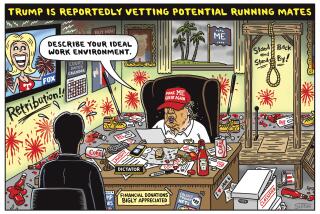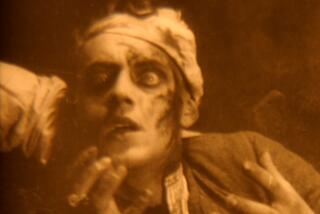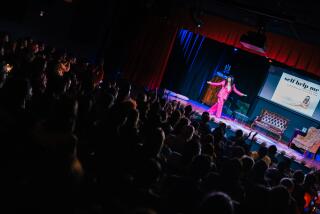Comics drawn into the battle
- Share via
One was like a kick in the gut, finding out that something terrible had happened to a lifelong friend. The other was just as jarring, a family dealing with a wartime tragedy.
And both happened in the funny pages. In “Doonesbury” last week, B.D., one of the comic’s longest-running characters, lost his leg in an Iraq firefight, and then his trademark helmet shortly after. At the same time, the strip “Get Fuzzy” featured a week in which the main character, Rob Wilco, met a military plane carrying his Marine cousin, who also had lost a leg in the war.
Taken together, the two strips struck a harsh and coincidental note, underscoring the role comic strips play as immediate social commentary, even under a thin veil of humor.
Editorial cartoonist Daryl Cagle said B.D.’s plight in particular was a hot topic of conversation last weekend at the annual meeting of the Assn. of American Editorial Cartoonists. But, he said, “I think it was more jarring that B.D.’s helmet came off.”
Garry Trudeau, who created “Doonesbury” in 1968 while a student at Yale, said he chose to have B.D. lose a leg to call attention to the “extreme price that many of our soldiers are now paying in our name.”
“B.D., being on the ground, as it were, was the logical candidate,” Trudeau said in an e-mail exchange. “And since he’s a long-running character with whom readers have a history, I thought his grievous wound would have more of an impact. More seemed at stake.”
Judging from the response, Trudeau got the impact he was looking for. Reader comments on the “Doonesbury” website have been mostly positive. Many wrote of bursting into tears as the story line became clear.
“I have been outraged by the war, lamented the fact that so many decent and fine people have been killed and maimed in the name of some crusade,” wrote one reader. “I’ve seen footage on the news, but it took seeing B.D. without his helmet and without his leg to bring tears to my eyes.”
Some, however, said they were shocked at what they considered inappropriate language and theme. “In addition to its unpatriotic tone during a time when we need to unite as a nation to face a common threat,” said one, “material of this nature is wholly inappropriate for family newspapers, particularly in the funny pages where it is likely to influence children.”
Those readers who have been upset should prepare themselves for more.
“B.D. has a long journey of healing and rehabilitation ahead of him,” said Trudeau. “I don’t want the grimness of this story to be unrelenting, but I will try to describe some of the many ways in which a wound of this severity can profoundly change a life.”
Mary Anne Grimes, a spokeswoman for United Feature Syndicate, which distributes “Get Fuzzy,” said she did not know whether creator Darby Conley would make the wounded cousin a recurring character in the strip. She also said he declined to be interviewed, preferring to let his strip do the talking.
During the week, the comic left behind the animal characters that generate most of its humor -- the mischievous Bucky Katt and the naive Satchel Pooch -- to take a serious turn. It not only introduced the Marine who’d lost his leg but also insinuated that the Bush administration had something to hide by having the military plane land at Andrews Air Force Base at 2 a.m., with Rob asking, “Shouldn’t these guys be getting back when people could welcome them home?” “Shhh,” whispers a government agent-type in the background.
Rod Gilchrist, the curator of San Francisco’s Cartoon Art Museum, said comics always have played the role of social commentator. And in the aftermath of Sept. 11, he said, much of the nation’s leadership was “bulletproof” from criticism, except from the comics. He cited in particular the strip “Boondocks,” with its acidic attacks on the Bush administration, even as the country mourned.
“That’s what makes the comics interesting,” he said. “I personally have a problem with strips like ‘Blondie’ and ‘Beetle Bailey.’ They have no basis in reality.”
Gilchrist said the museum last year put on a show called “Hate Mail,” designed to show how the comics are a constant source of adult ire. The show featured inflammatory cartoons from seven artists, including Trudeau and “Boondock’s” Aaron McGruder, as well as the angry responses from readers. And the exhibit also pointed out that social commentary dated back to the likes of “Pogo” and “Little Orphan Annie.” “Pogo” routinely lampooned McCarthy-era communist baiting, and “Little Orphan Annie” was used as a platform to criticize Franklin D. Roosevelt’s New Deal politics.
More recently, the caveman-themed comic “B.C.” has become well-known for espousing conservative Christian views around Christmas and Easter.
Steve McGarry, president of the National Cartoonists Society, said all comic strips could not be lumped together because they played different roles.
“It would be remiss of Trudeau not to address the war because that is his milieu,” he said. “But it would be ridiculous if ‘Garfield’ started adopting the same themes.”
He wasn’t particularly surprised that Conley took on the war in his strip, though. “I think anyone who follows ‘Get Fuzzy’ knows that Darby shines his light in a few dark corners,” he said.
“Doonesbury,” of course, has a long history of shining lights in dark corners, particularly when it comes to lampooning politicians in general and the White House in particular. President Ford once said there were three main sources of information about what is going on in Washington: the electronic media, the print media and “Doonesbury.”
So controversial was it in its early days that the U.S. military’s newspaper, Stars and Stripes, dropped it in 1973 as too political only to reinstate it after a flurry of protests by readers. The Lincoln Journal in Nebraska became the first newspaper to move the strip to its editorial pages that same year.
War, of course, has long been depicted in cartoons. Among the most famous was Bill Mauldin’s “Willie and Joe,” which ran in Stars and Stripes during World War II. The cartoons focused on the life and gripes of Army grunts. But Cagle said Mauldin should not be compared to Trudeau.
“With ‘Doonesbury,’ Garry Trudeau is a social critic opposed to the war,” he said. “He’s writing not for the soldiers but the folks back home.”
Even if it’s painful to read it.
More to Read
The biggest entertainment stories
Get our big stories about Hollywood, film, television, music, arts, culture and more right in your inbox as soon as they publish.
You may occasionally receive promotional content from the Los Angeles Times.










